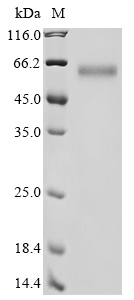Amino acids 1-570 constitute the expression domain of recombinant Human DPYSL3. The theoretical molecular weight of the DPYSL3 protein is 66.0 kDa. This DPYSL3 recombinant protein is manufactured in e.coli. Fusion of the N-terminal 6xHis tag into the DPYSL3 encoding gene fragment was conducted, allowing for easier detection and purification of the DPYSL3 protein in subsequent stages.
Human dihydropyrimidinase-related protein 3 (DPYSL3) is a cytoplasmic protein involved in neurite outgrowth and axon guidance during neuronal development. DPYSL3 functions as a collapsin response mediator, influencing cytoskeletal dynamics and neuronal morphology. In neurobiology, DPYSL3 is crucial for axon guidance, neuronal differentiation, and synaptic plasticity. Its dysregulation is implicated in neurodevelopmental disorders and neurodegenerative diseases. In cancer research, DPYSL3 may contribute to tumor invasion and metastasis. Investigating DPYSL3 provides insights into neurodevelopment and neurological disorders, offering potential applications in understanding and treating conditions related to aberrant neurite outgrowth. Additionally, exploring its role in cancer may unveil new targets for cancer therapy and metastasis prevention.






